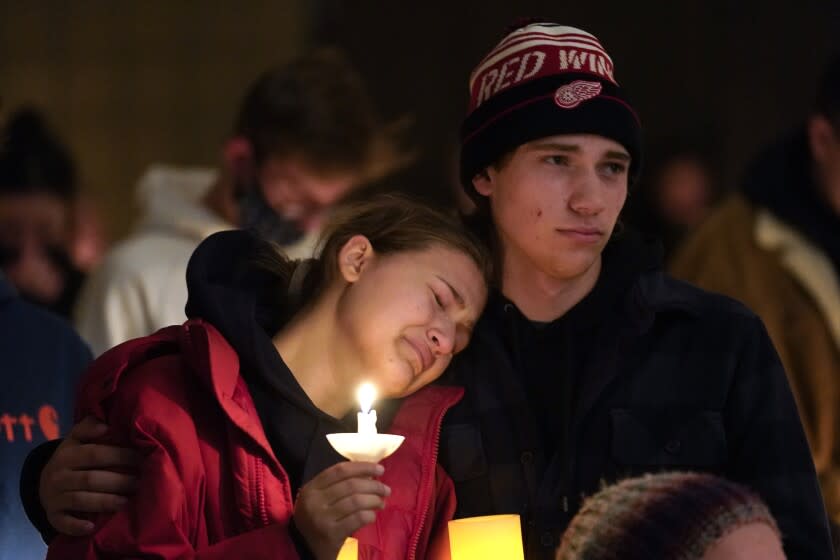Editorial: California's efforts to protect citizens from wanton gun violence are still in danger

On the day the U.S. 9th Circuit Court of Appeals upheld California’s common-sense laws to limit the multiple-murderous potential of some firearms, and the Los Angeles City Council belatedly banned untraceable “ghost guns” within city limits, four teenagers were shot dead and several other people wounded in their own high school in Oxford, Mich., just north of Detroit. The suspect is a fellow student.
The 12-judge 9th Circuit en banc ruling was not unanimous. Four members would have upheld a lower court judge who struck down the ban and in the process compared the type of semiautomatic weapon used to kill 12 moviegoers in Aurora, Colo., in 2012, 20 young children at Sandy Hook Elementary School in Newtown, Conn., in 2012, 14 county workers and guests at a holiday party in San Bernardino in 2015, 49 revelers at the Pulse nightclub in Orlando in 2016, many of the 60 shot dead at a Las Vegas music festival in 2017, 26 churchgoers in Sutherland Springs, Texas, in 2017, 17 students and staff at the Marjory Stoneman Douglas High School in Parkland, Fla., in 2018, 11 worshippers at the Tree of Life synagogue in Pittsburgh in 2018, one at a Poway synagogue in 2019 and 10 in a Boulder, Colo., parking lot earlier this year —
— apologies, that was a lot of killings and we briefly lost our place. The lower court judge compared the AR-15-style weapons that have killed so many innocent people with a Swiss Army knife, “good for both home and battle.”
For the dissenting judges, all those high-profile killings weren’t enough to justify government action because they are “statistically very rare,” by which they perhaps were thinking about how the nation’s semiautomatic weapon body count is dwarfed by the many thousands of killings facilitated by more modest tools of death, such as semiautomatic handguns of the type recovered at the deadly scene in Michigan, and ghost guns, which are assembled from kits.
In a battle of footnotes, one dissenting judge noted that although airplane crashes are horrible, they are rare enough that the government does not ban planes, and the same thinking should apply to guns that can fire more than 10 rounds without reloading. Yes, replied Judge Susan P. Graber, writing for the majority, air crashes are rare, yet even so they cause enough harm to justify laws that closely regulate the airline and airplane manufacturing industries. She ought to have added that deadly crashes today may be so rare precisely because of regulation, and that with a little more sensible regulation of firearms, gun deaths, too, just might one day become a little more rare.
For the present, gun deaths are depressingly common — nearly 40,000 in 2019, the year before the pandemic violent crime wave began its run. That figure includes suicides. And it includes senseless killings such as Tuesday’s in Michigan.
An increasing number of deaths are inflicted by people wielding ghost guns, assembled from handgun components that skirt laws requiring firearms to carry serial numbers because they are not yet firearms when they are sold. That’s a little like not requiring automobiles that are assembled from parts at home to have VIN numbers or license plates, except that of course they must.
It’s virtually impossible to determine how many people ghost guns have killed, because it is impossible to know how many there are, and in whose hands. Kudos to the L.A. City Council for following the incrementally more timely actions of San Diego and San Francisco, but a ban on untraceable guns will be, almost by definition, difficult to enforce without a serious nationwide effort.
The ban will almost certainly be challenged by the gun lobby and others speaking for gun (and gun parts) manufacturers — the same interests that vowed to appeal the 9th Circuit’s ruling upholding the ban on high-capacity ammunition magazines. They will no doubt argue that ghost guns, and equipment that allows shooters to get off more than 10 shots without reloading, are protected by the 2nd Amendment right to keep and bear arms, which in the late 18th century was deemed “necessary to the security of a free State.”
No other “free State” hosts such wanton killing or is in such thrall to the gun lobby and its political clients as the United States. Nations where gun violence is even more rampant, such as, say, El Salvador, are so crippled by killing and fear that their people can hardly be called free.
Within the U.S., California is one state with the wisdom to protect its citizens’ lives by offering a modicum of legislation that has little impact on their liberties, except perhaps the liberty to kill themselves, their families and complete strangers. But California’s protections are in danger from less enlightened judges and justices who appear to believe in the right to commit national suicide, misusing the Bill of Rights to deprive “we the people” of the right to go to school, church, synagogue, the store, concerts, movies and parties and come back alive.
This story originally appeared in Los Angeles Times.

